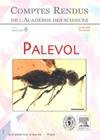Exceptionally preserved calcified sponge assemblagesin Upper Jurassic carbonates of the eastern Getic Carbonate Platform (Southern Carpathians, Romania)
IF 1.3
4区 地球科学
Q3 PALEONTOLOGY
引用次数: 2
Abstract
A rich poriferan assemblage was identified within the easternmost part of the Getic Carbonate Platform of Romania (Grădiștei Gorges). The excellent preservation state of most poriferans here led to the discovery of a new species (Neuropora gigantea Pleș & Schlagintweit, n. sp.) and to the identification of previously unknown diagnostic features in some species (Sarsteinia babai Schlagintweit & Gawlick, 2006 emend., Neuropora lusitanica Termier, 1985, Sphaeractinia steinmanni Canavari, 1893). Calciagglutispongia yabei Reitner, 1992, Sarsteinia babai and Sphaeractinia steinmanni are reported for the first time from the Upper Jurassic carbonates of the Getic Carbonate Platform. The sedimentary input fluctuations and the nutrient competition had an important role in understanding the morphological adaptations of the analysed species. The existing palaeoecological and palaeoenvironmental conditions generated different distribution patterns towards the reef profile and also preferential adaptations to a specific Tethyan domain. As opposed to the poriferan assemblages from the northern Tethyan shelves, these organisms formed sponge-coral-microencruster boundstones at the margins and fore-reefal zones of isolated carbonate platforms within the intra-Tethyan realm. The importance of calcified sponges in reef-zonation is highlighted by the establishment of a general zonation model. Three zones can be distinguished: 1) Cladocoropsis-Milleporidium zone (back-reef area); 2) Bauneia-Chaetetopsis-Parastromatopora zone (central reef area); and 3) Sphaeractinia/Ellipsactinia-Neuropora zone for the fore-reef area. In the absence of a true reef framework these calcified sponges developed typical morphologies, environmental adaptations and partnerships with other biotic groups which strongly influenced the carbonate production throughout the intra-Tethyan domain.罗马尼亚南喀尔巴阡山脉东部碳酸盐岩地台上侏罗统碳酸盐岩中保存异常的钙化海绵组合
在罗马尼亚碳酸盐岩地台最东端(Grădiștei Gorges)发现了丰富的多孔岩组合。这里大多数多孔虫的良好保存状态导致了一个新物种的发现(Neuropora gigantea pleau & Schlagintweit, n.sp .),并在一些物种中发现了以前未知的诊断特征(Sarsteinia babai Schlagintweit & Gawlick, 2006年修订)。, Neuropora lusitanica Termier, 1985, Sphaeractinia steinmanni Canavari, 1893)。calagglutispongia yabei Reitner, 1992, Sarsteinia babai和Sphaeractinia steinmanni在上侏罗统碳酸盐岩中首次报道。沉积物输入波动和养分竞争对了解所分析物种的形态适应具有重要作用。现有的古生态和古环境条件对礁剖面产生了不同的分布格局,并对特定的特提斯域产生了优先适应。与来自特提斯北部大陆架的多孔岩组合相反,这些生物在特提斯境内孤立的碳酸盐台地的边缘和礁前地带形成了海绵-珊瑚-微壳壳结合岩。通过建立一般的分带模型,突出了钙化海绵在珊瑚礁分带中的重要性。可分为3个区:1)枝状体-千禧年区(礁后区);2) baunia - chaetetoposis - parastromatopora带(礁中央区);3)礁前区为Sphaeractinia/Ellipsactinia-Neuropora区。在没有真正的珊瑚礁框架的情况下,这些钙化海绵形成了典型的形态、环境适应和与其他生物群的伙伴关系,这些生物群强烈影响了整个特提斯内部区域的碳酸盐生产。
本文章由计算机程序翻译,如有差异,请以英文原文为准。
求助全文
约1分钟内获得全文
求助全文
来源期刊

Comptes Rendus Palevol
地学-古生物学
CiteScore
2.10
自引率
0.00%
发文量
39
审稿时长
17.6 weeks
期刊介绍:
Comptes Rendus Palevol is a fully electronic and peer-reviewed journal, with a continuous publication stream, devoted to palaeontology, prehistory and evolutionary sciences. It publishes original research results, in French or English, in the following domains: systematic and human palaeontology, prehistory, evolutionary biology and macroevolution, and history of sciences. Thematic issues may also be published under the responsibility of a guest editor. All articles published in Comptes Rendus Palevol are compliant with the different nomenclatural codes. A copyright assignment will be signed by the authors before publication.
 求助内容:
求助内容: 应助结果提醒方式:
应助结果提醒方式:


